Please Take Note: This is a review of the final game, but it might change slightly based on the success of the Kickstarter campaign. The game is being reviewed on the components and the rules provided with the understanding that “what you see is not what you might get” when the game is published. If you like what you read and want to learn more, we encourage you to visit the Kickstarter campaign. Now that we have all that disclaimer junk out of the way, on with the review
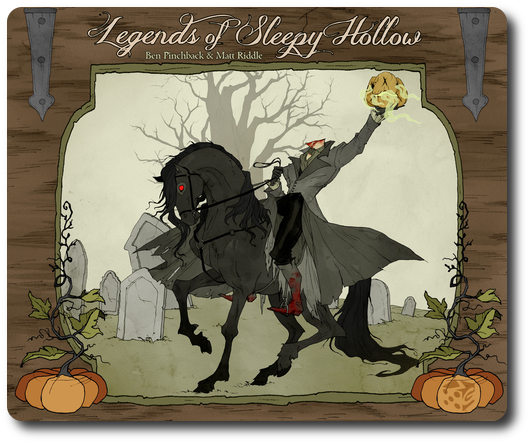
The Basics:
- For ages 12 and up
- For 1 to 4 players
- Approximately 60 minutes to complete
Geek Skills:
- Active Listening & Communication
- Counting & Math
- Logical & Critical Decision Making
- Reading
- Strategy & Tactics
- Cooperative & Team Play
- Hand/Resource Management
Learning Curve:
- Child – Easy
- Adult – Easy
Theme & Narrative:
- Solve the mystery, defeat evil, and survive (in that order)!
Endorsements:
- Gamer Geek approved!
- Parent Geek approved!
- Child Geek approved!
Overview
You might have heard the story of the unfortunate school teacher, Ichabod Crane, and his horrific encounter with the Headless Horseman, but you haven’t heard it all. There are darker stories and deeper mysteries to be found in the misty forests surrounding Sleepy Hollow. Evil lurks here and ancient darkness stirs. It’s up to you, an unlikely band of heroes, to defend the people and shine a light where only shadows dwell.
Legends of Sleepy Hollow, designed by Ben Pinchback, Matt Riddle and to be published by Greater Than Games and Dice Hate Me Games, will reportedly be comprised of 16 Map tiles, 4 Hero miniatures, 10 Gobkins miniatures (ugly pumpkin dudes), 10 Schrikroot miniatures (even uglier tree dudes), 15 yet to be determined miniatures, over 140 mini-sized cards (for the Legends story deck, Character Skills, Skill Upgrades, and Foes), over 50 bridge-sized cards (for Character Equipment and Proficiency Upgrades), 4 Player mats (with wells for tokens and upgrade cards), 20 Action tokens, 25 Fear tokens, 6 custom dice, 1 standard six-sided die, 40 Damage rings (attach to bottom of the miniature bases to track damage), and 1 24-page Storybook (containing Chapter details, story elements, and game mats). As this is a review of a prepublished game, I cannot comment on the game component quality. Greater Than Games has a history of releasing quality products and this game appears to be no differently, boasting components made of well sculpted plastic and thick wood bits. Throw in the excellent illustrations by Colin Chan, Abigail Larson, and Ksenia Svincova, and this should be a wonderful game to look at.

But how does it play…?
Welcome to the Hollow
Note: The game set up and subsequent game play summary is based on a preview rule set of the first chapter. As this is a game of exploration and mystery, the discovery and story elements are not discussed here so as to not spoil your own Sleepy Hollow exploration. Many of the bits come in envelopes with instructions on when to open them. This is done on purpose so as to allow the game the evolve and be slowly revealed over the game play, leaving the players guessing what will be coming next!
To set up the game, first place the Schoolhouse Map board in the middle of the playing area.
Second, place all the Discovery tokens face-down, randomize them, and then place one on each of the Discovery token spots on the map, making certain not to reveal their face-down side.
Third, place the Chapter 1 card next to the Map tile and add the Pumpkin token to the first spot on the card (the Move/Spawn/Attack space).
Fourth, shuffle the Legend deck and place it face-down next to the map, as well as the Schrikroot and Gobkin cards for reference. Place the initial Schrikroot and Gobkin miniatures on the map at this time.
Fifth, give each player their choice of Player mat, 2 Starting Skill cards, Action tokens, Health tokens, and matching Hero miniature. Place the Hero miniatures on the starting spot found on the map. If playing with less than four players, have as many players as necessary play two or more characters.
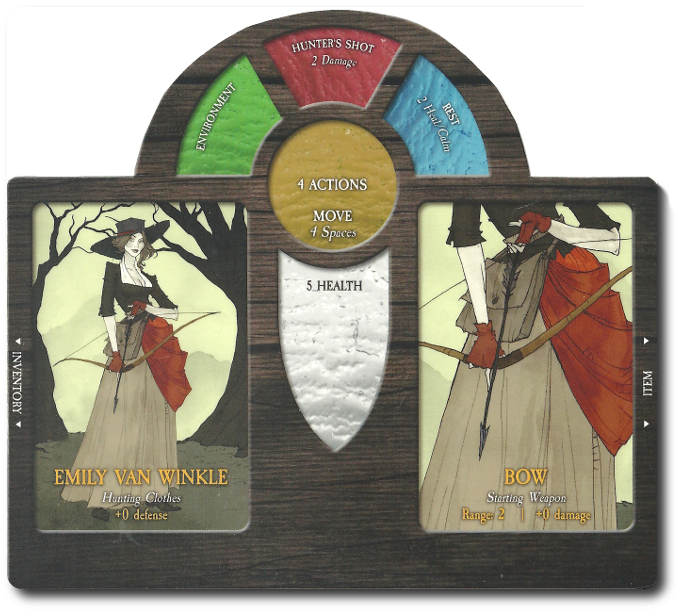
Sixth, place the dice and other revealed game components to one side of the game playing area and within easy reach. Leave all other game components not yet revealed (i.e. “in envelopes”) in the game box. You’ll get those later when the game calls for it.
That’s it for game set up. Time to solve a mystery! Read the chapter introduction to add thematic flavor and make sure everyone knows what needs to be done to win. All of which is summarized on the Chapter card.
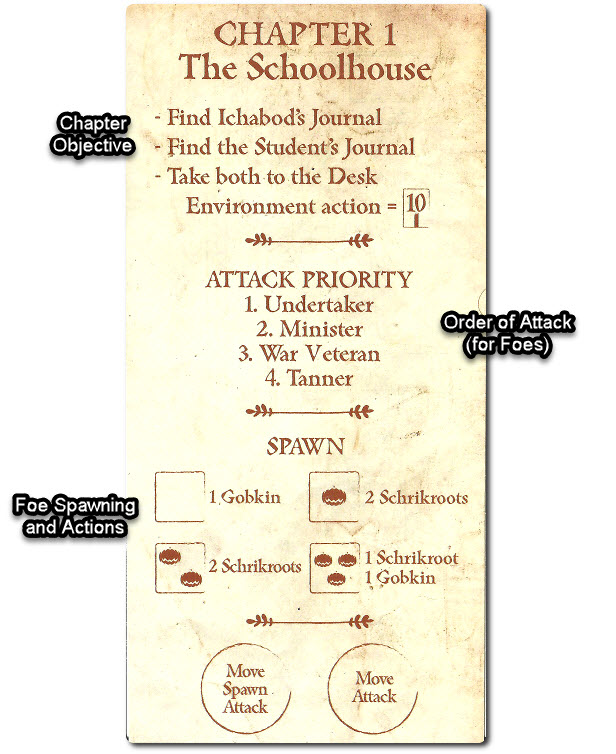
Through Mist and Mayhem
Legends of Sleepy Hollow is played in rounds and turns. Players go first and can decide the turn order in which they play each and every round, changing it every round if they so like. A typical game round is summarized here.
Step 1: Swap Items and Assign Actions
Each player takes an Action token or a Fear token and moves it to an available Action slot on their Character mat or Skill cards. Some Action slots (like Environment, Attack, and Rest) can have any many tokens as needed by the player, while others only take specific tokens of a limited number per round.
The Attack action allows the player to enter melee combat or ranged combat. The damage they deal is listed on their skills, which will be altered with bonuses and equipment. The success of an attack is determined by rolling one or more Attack dice.
The Environment action allows the player to interact with other game board elements located in the same space as the player’s Hero miniature. For example, opening a desk, flipping over tokens, and even giving items to other nearby Heroes. Found new items and equipment can be equipped as soon as they are drawn, swapping out any currently equipped item. A player may never activate an Environment action if a foe is occupying the same space as the Hero miniature.
The Rest action heals the Hero a little bit or removes Fear tokens.
Additional actions are provided by various items that have an available Action slot. These cards will have one or more Actions slots, requiring the same number of Action and Fear tokens to activate them. Only one Item can be equipped per Hero at a time, but can hold an unlimited number of Item cards at the ready. During this step of the player’s turn, they can adjust which item they have in play, swapping out the Item currently attached to their Hero with another. Keep in mind that players must first pass Items to another player using the Environment action, meaning a player must first receive a new item from another player during the first round and on the next round they can equip it.
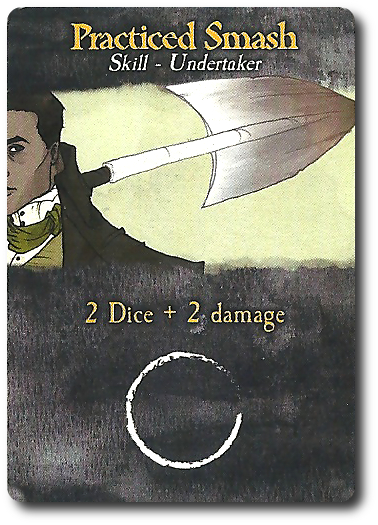
Step 2: Resolve Actions and Movement
Using the turn order sequence decided by the group, each player will make a Move and an Action or Action and then Move. All movement, line of sight, and range is calculated orthogonally, meaning no diagonal lines are allowed, kiddos. Certain elements on the map (like bookcases and walls) block line of sight, break ranged combat, and cannot be moved through providing both cover and an obstacle. Other Heroes and Foes never block line of sight.
Each player now resolves their turn, attacking, exploring, resting or using specific actions. Each character brings to the table a unique set of Skills and Actions, giving the players a lot of customization about how they want to go about winning the game. Communication and timing is key here and the players will quickly learn that setting up their movement and actions should not be done in a vacuum. This is very much a cooperative game.
Heroes can move from a space occupied by Foes, but doing so allows the Foes to make a free attack which will possibly inflict damage, but never fear.
Step 3: It’s the Foes’ Turn…
All those baddies on the map now jump to life and take their action. What actions they take is determined by the Chapter 1 card and the current position of the Pumpkin token. This includes spawning more bad guys, movement, and attacking or any combination of the three. The Pumpkin token is adjusted each round, making the actions the foes take different each round, but also predictable.
The Move action moves all currently placed Foes one space towards the closest character. Whenever there is some doubt on where the Foe should move, enact the “Mean Rule”, which clearly states that the Foes would take any action that is directly against the player’s and Hero’s best interest. When torn between which Hero to attack, a Foe will use the Attack Priority (noted on the Chapter card) and will never leave a spot occupied with a Hero. A maximum of four Foes can occupy the same space at a time.
The Spawn action is completed by rolling a die and comparing the results to the Chapter card. The indicated number of Foes are added to the map randomly by again rolling a die and adding the Foe miniature to the corresponding space on the map.
The Attack action will allow the Foes to attack once per round at the closest Hero they can reach. Some Foes have a ranged attack, in which case, they attack the closest Hero within range and within line of sight. A Hero might have equipment that will reduce the total damage inflicted. For each damage done to a Hero, the player reduces their total Health. Removing all the Health tokens incapacitates the Hero and the players lose the game. So don’t’ let that happen. Heroes will also collect Fear tokens even if they avoid taking damage. If the player collects 10 or more Fear tokens, the Hero bravely runs away and the players lose the game. So don’t let that happen either.
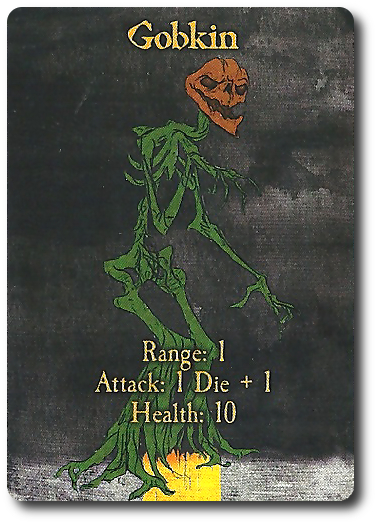
After all the Foes have had a chance to take an action and movement, the round ends and a new round begins.
A Grave End or a Triumphant Victory
Players win the game by completing the defined Chapter objective. There is a different objective per chapter. For the first chapter, the players were required to explore the schoolhouse and find a specific item, all the while fighting off foes and staying alive. In addition, the players get to learn more about the legends about Sleepy Hollow, revealing the goodies only provided at the end of the chapter if successfully completed. New items and skills can also be unlocked. Sorry, I’ve been asked by the game publishers not to reveal what awesomeness awaits you other than in the most general of terms.
Players lose if any Hero is incapacitated, runs away in fear, or if the supply of available Foes is depleted and no more can be spawned (thus overwhelming the Heroes).
To learn more about Legends of Sleepy Hollow, visit the Kickstarter campaign.
Final Word
 The Child Geeks had a lot of fun with this one, which most likely due to the game’s theme, but also the season. Seeing that it’s October, anything “Halloween’ish” is a big hit right now. That being said, even a game with scary thematic elements and a mysterious narrative must keep the player engaged. Legends of Sleepy Hollow had no problem grabbing onto the imagination of the Child Geeks and never once let go. According to one Child Geek, “I like how the game feels like a hunt and a battle. I think the best part of the game was working together as a team.” Another Child Geek said, “The hardest part of this game is knowing when to go looking for clues and when to go punch a bad guy in the face.” After the last evil pumpkin was smashed and the mystery somewhat solved, the Child Geeks all agreed that Legends of Sleepy Hollow was anything but a snoozefest.
The Child Geeks had a lot of fun with this one, which most likely due to the game’s theme, but also the season. Seeing that it’s October, anything “Halloween’ish” is a big hit right now. That being said, even a game with scary thematic elements and a mysterious narrative must keep the player engaged. Legends of Sleepy Hollow had no problem grabbing onto the imagination of the Child Geeks and never once let go. According to one Child Geek, “I like how the game feels like a hunt and a battle. I think the best part of the game was working together as a team.” Another Child Geek said, “The hardest part of this game is knowing when to go looking for clues and when to go punch a bad guy in the face.” After the last evil pumpkin was smashed and the mystery somewhat solved, the Child Geeks all agreed that Legends of Sleepy Hollow was anything but a snoozefest.
 The Parent Geeks are currently somewhat burned out on battle games, finding the constant focus on aggressive game play to be tiring. This did not change, but Legends of Sleepy Hollow kept them engaged and most importantly, riveted. According to on Parent Geek, “I’m a bit tired of all these fighting games, but I found this one to be a bit different. You still have to fight, but I like that your actions are part of a story, a bigger mystery, in which you play a part.” Another Parent Geek said, “Other games we have played in the past just throw the players into combat with little in the way of providing reason. I always knew what our team was about doing and why. I liked that a lot.” The Parent Geeks found that they liked the game with both their peers and their families, giving Legends of Sleepy Hollow their full endorsement.
The Parent Geeks are currently somewhat burned out on battle games, finding the constant focus on aggressive game play to be tiring. This did not change, but Legends of Sleepy Hollow kept them engaged and most importantly, riveted. According to on Parent Geek, “I’m a bit tired of all these fighting games, but I found this one to be a bit different. You still have to fight, but I like that your actions are part of a story, a bigger mystery, in which you play a part.” Another Parent Geek said, “Other games we have played in the past just throw the players into combat with little in the way of providing reason. I always knew what our team was about doing and why. I liked that a lot.” The Parent Geeks found that they liked the game with both their peers and their families, giving Legends of Sleepy Hollow their full endorsement.
 The Gamer Geeks didn’t see a lot in the game that was new, but it excited them all the same. According to one Gamer Geek, “I like how the players have to make their choices with limits, forcing each player to carefully consider possible outcomes. I also like that you can see doom approaching. This helped me and the rest of the players make better choices, while not ever feeling like the game was going easy on us.” Another Gamer Geek said, “A very good game, in my opinion. It’s strategic, you must be tactical, you have to work as a team, manage your threat, and push the limits. I really enjoyed myself. And the theme? Excellent!” The Gamer Geeks applauded Legends of Sleepy Hollow, welcoming it back to their gaming table as soon as more chapters in the story were available.
The Gamer Geeks didn’t see a lot in the game that was new, but it excited them all the same. According to one Gamer Geek, “I like how the players have to make their choices with limits, forcing each player to carefully consider possible outcomes. I also like that you can see doom approaching. This helped me and the rest of the players make better choices, while not ever feeling like the game was going easy on us.” Another Gamer Geek said, “A very good game, in my opinion. It’s strategic, you must be tactical, you have to work as a team, manage your threat, and push the limits. I really enjoyed myself. And the theme? Excellent!” The Gamer Geeks applauded Legends of Sleepy Hollow, welcoming it back to their gaming table as soon as more chapters in the story were available.
 I’ve said it before and I’ll say it again, I’ve played a lot of games and Legends of Sleepy Hollow smacks of mediocrity. Right from the start, you are doing little more than what has already been done by many other miniature games. There is nothing new here when it comes to game play or game mechanics.
I’ve said it before and I’ll say it again, I’ve played a lot of games and Legends of Sleepy Hollow smacks of mediocrity. Right from the start, you are doing little more than what has already been done by many other miniature games. There is nothing new here when it comes to game play or game mechanics.
But hold on one moment, if you please…
This game rises above the tempest-tossed waters of averageness due to its execution of story, theme, and narrative. This game feels like an adventure, a mystery to be solved, dangerous, and best of all, important. Players’ choices to rush into combat or search the bookshelves feel like important things to ponder. Moving as a group and protecting the backs of those who are scrounging for clues is a necessity. The game empowers the players to do what they think is right and take all the risk, all the while unload more and more foes, aggressively attacking, and not once holding back. I felt a bit stressed more than once and that, my friends, made this game awesome. If I don’t think my choices have meaning and my actions have consequences, why spend any energy in the first place?
I was most pleased with Legends of Sleepy Hollow, but I am concerned about its replayability. Each group played the game three times and by the time the third game started, the players knew exactly what to expect and how to go about winning the game. The mystery was solved and the level of excitement and engagement had dropped. That’s not a good thing. Items are randomly placed, forcing the players to search for things, but that just adds time, not difficulty. Without the “twist” at the end, the game became less interesting. The game publishers will be releasing maps and rules that will increase the difficulty of the game play, but I am not convinced that will replace the wonder and exciting of solving a mystery. I remain skeptical, but enthusiastic.
If you like cooperative fighting games, where the players are pitted against nasty things that go bump in the night, and there is a mystery to be solved (but only once), then do try Legends of Sleepy Hollow.
This game was given to Father Geek as a review copy. Father Geek was not paid, bribed, wined, dined, or threatened in vain hopes of influencing this review. Such is the statuesque and legendary integrity of Father Geek.




This is a cool review. I just discovered your blog and I appreciate the depth that you’ve gone through describing the game and the multiple perspectives for opinions on the game.
The style of the game definitely caught my attention. I’m digging that more games are being published with more of a hard line illustration style. It’s very cool.
Welcome to Father Geek and thanks for taking the time to read our reviews. I think you’ll find that the art direction in most games tend to follow patterns. At least those that are targeted towards the “serious gamer”. When such a group buys a game, they often take into account how good the game looks on their table, not just how well it plays.